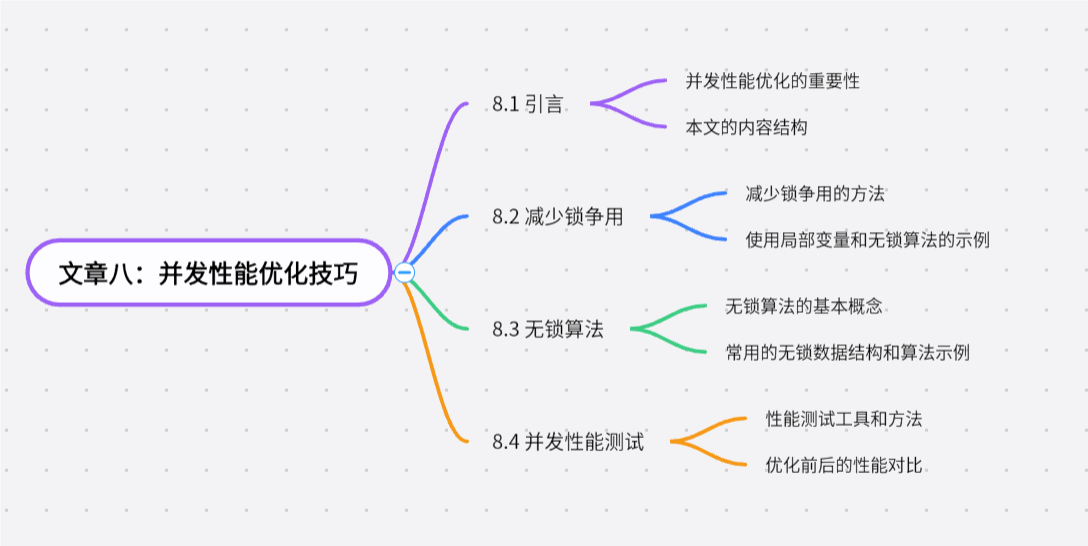目录

8.1 引言
并发性能优化的重要性
在并发编程中,性能优化是确保系统在高并发环境下稳定、高效运行的关键。良好的并发性能优化可以显著提高系统的吞吐量、降低响应时间,并充分利用硬件资源。优化并发性能不仅能提升用户体验,还能减少硬件成本和运营开销。因此,掌握并发性能优化的技巧是每个开发者必须具备的能力。
本文的内容结构
本文将介绍几种常见的并发性能优化技巧,主要内容包括:
- 减少锁争用
- 无锁算法
- 并发性能测试
8.2 减少锁争用
减少锁争用的方法
锁争用是指多个线程竞争同一个锁,导致线程阻塞和上下文切换,进而影响系统性能。减少锁争用的方法包括:
- 减小锁的粒度:将大锁拆分为多个小锁,以减少每个锁的竞争。
- 缩短持锁时间:减少锁定时间,将需要同步的代码块尽量缩小。
- 锁分离技术:将读写操作分离,使用读写锁(ReadWriteLock)来提高并发性。
- 避免过度同步:只在必要时进行同步,尽量减少不必要的同步操作。
使用局部变量和无锁算法的示例
使用局部变量
局部变量是线程安全的,因为它们存储在线程栈中,不会被其他线程访问。通过使用局部变量,可以减少锁的使用,提升性能。
public class LocalVariableDemo { public void process() { int localVar = 0; // 局部变量 for (int i = 0; i < 1000; i++) { localVar += i; } System.out.println("Result: " + localVar); } public static void main(String[] args) { LocalVariableDemo demo = new LocalVariableDemo(); Thread thread1 = new Thread(demo::process); Thread thread2 = new Thread(demo::process); thread1.start(); thread2.start(); } } 无锁算法
无锁算法通过使用原子操作(如CAS操作)来避免锁的使用,提高并发性能。Java提供了java.util.concurrent.atomic包中的原子类,如AtomicInteger、AtomicLong等。
import java.util.concurrent.atomic.AtomicInteger; public class AtomicDemo { private AtomicInteger count = new AtomicInteger(0); public void increment() { for (int i = 0; i < 1000; i++) { count.getAndIncrement(); } } public static void main(String[] args) throws InterruptedException { AtomicDemo demo = new AtomicDemo(); Thread thread1 = new Thread(demo::increment); Thread thread2 = new Thread(demo::increment); thread1.start(); thread2.start(); thread1.join(); thread2.join(); System.out.println("Final count: " + demo.count); } } 8.3 无锁算法
无锁算法的基本概念
无锁算法(Lock-Free Algorithm)是指在多线程环境下,通过使用原子操作(如CAS操作)实现数据的并发访问而不使用锁的算法。无锁算法可以避免线程阻塞和上下文切换,提高并发性能和系统的响应速度。
常用的无锁数据结构和算法示例
无锁队列
ConcurrentLinkedQueue是一个基于无锁算法的并发队列,实现了高效的并发访问。
import java.util.Queue; import java.util.concurrent.ConcurrentLinkedQueue; public class ConcurrentQueueDemo { private Queue<Integer> queue = new ConcurrentLinkedQueue<>(); public void addToQueue() { for (int i = 0; i < 1000; i++) { queue.add(i); } } public void removeFromQueue() { while (!queue.isEmpty()) { queue.poll(); } } public static void main(String[] args) throws InterruptedException { ConcurrentQueueDemo demo = new ConcurrentQueueDemo(); Thread thread1 = new Thread(demo::addToQueue); Thread thread2 = new Thread(demo::removeFromQueue); thread1.start(); thread2.start(); thread1.join(); thread2.join(); System.out.println("Final queue size: " + demo.queue.size()); } } 无锁栈
ConcurrentLinkedDeque是一个基于无锁算法的并发双端队列,可以用作栈来实现高效的并发访问。
import java.util.Deque; import java.util.concurrent.ConcurrentLinkedDeque; public class ConcurrentStackDemo { private Deque<Integer> stack = new ConcurrentLinkedDeque<>(); public void pushToStack() { for (int i = 0; i < 1000; i++) { stack.push(i); } } public void popFromStack() { while (!stack.isEmpty()) { stack.pop(); } } public static void main(String[] args) throws InterruptedException { ConcurrentStackDemo demo = new ConcurrentStackDemo(); Thread thread1 = new Thread(demo::pushToStack); Thread thread2 = new Thread(demo::popFromStack); thread1.start(); thread2.start(); thread1.join(); thread2.join(); System.out.println("Final stack size: " + demo.stack.size()); } } 8.4 并发性能测试
性能测试工具和方法
在进行并发性能优化之前,需要对系统的性能进行评估和测试,以确定性能瓶颈。常用的性能测试工具和方法包括:
- JMH(Java Microbenchmark Harness):用于微基准测试,评估代码的性能。
- JProfiler:Java性能分析工具,用于分析CPU和内存使用情况。
- VisualVM:Java虚拟机监视、分析工具,提供实时的性能监控和分析功能。
- 压力测试工具:如JMeter、Gatling,用于模拟高并发环境,测试系统的性能和稳定性。
使用JMH进行性能测试
import org.openjdk.jmh.annotations.*; import java.util.concurrent.TimeUnit; import java.util.concurrent.atomic.AtomicInteger; @State(Scope.Benchmark) public class JMHTest { private AtomicInteger atomicInteger = new AtomicInteger(); @Benchmark @BenchmarkMode(Mode.Throughput) @OutputTimeUnit(TimeUnit.SECONDS) public void testAtomicIncrement() { atomicInteger.getAndIncrement(); } public static void main(String[] args) throws Exception { org.openjdk.jmh.Main.main(args); } } 优化前后的性能对比
在进行性能优化后,需要再次进行性能测试,以评估优化效果。通过对比优化前后的性能数据,可以确定优化的有效性。
示例:优化前后的性能对比
假设我们有一段使用同步块的代码,优化前后的性能对比如下:
public class SynchronizedCounter { private int count = 0; public synchronized void increment() { count++; } public int getCount() { return count; } } 优化后,使用原子操作:
import java.util.concurrent.atomic.AtomicInteger; public class AtomicCounter { private AtomicInteger count = new AtomicInteger(0); public void increment() { count.getAndIncrement(); } public int getCount() { return count.get(); } } 通过JMH进行性能测试,可以发现使用原子操作的性能显著优于使用同步块的性能。
结论
本文详细介绍了几种常见的并发性能优化技巧,包括减少锁争用、使用无锁算法以及并发性能测试。通过这些优化技巧,开发者可以显著提高系统的并发性能和稳定性。在实际开发中,根据具体需求选择合适的优化策略,可以大大提升系统的性能和用户体验。希望本文对你有所帮助,敬请期待专栏的下一篇文章。
